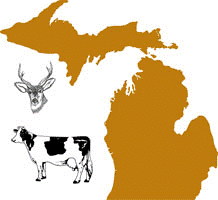Wildlife Disease and Zoonotics

Michigan Bovine Tuberculosis Bibliography and Database
Date of this Version
6-15-2000
Abstract
Objective—To determine the distribution of lesions and extent of tissues infected with Mycobacterium bovis in a captive population of white-tailed deer.
Design—Cross-sectional study.
Animals—116 captive white-tailed deer.
Procedure—Deer were euthanatized, and postmortem examinations were performed. Tissues with gross lesions suggestive of tuberculosis were collected for microscopic analysis and bacteriologic culture. Tissues from the head, thorax, and abdomen of deer with no gross lesions were pooled for bacteriologic culture. Tonsillar, nasal, oral, and rectal swab specimens, fecal samples, and samples of hay and pelleted feed, soil around feeding sites, and water from 2 natural ponds were collected for bacteriologic culture.
Results—Mycobacterium bovis was isolated from 14 of 116 (12%) deer; however, only 9 of 14 had lesions consistent with tuberculosis. Most commonly affected tissues included the medial retropharyngeal lymph node and lung. Five of 14 tuberculous deer had no gross lesions; however,M bovis was isolated from pooled tissue specimens from the heads of each of these deer. Bacteriologic culture of tonsillar swab specimens from 2 of the infected deer yielded M bovis. Mean (± SEM) age of tuberculous deer was 2.5 ± 0.3 years (range, 0.5 to 6 years). Mycobacterium bovis was not isolated from feed, soil, water, or fecal samples.
Conclusions and Clinical Relevance—Examination of hunter-killed white-tailed deer for tuberculosis commonly includes only the lymph nodes of the head. Results of such examinations may underestimate disease prevalence by as much as 57%. Such discrepancy should be considered when estimating disease prevalence.


Comments
Published in JAVMA, Vol 216, No. 12, June 15, 2000.